Download PROCESS Macro for SPSS
PROCESS v5.0 is available for free download from the CCRAM (Centre for Research Analysis Methods) at the University of Calgary:
Look for the "PROCESS macro for SPSS, SAS, and R" section on the resource hub page.
What You'll Download:
- PROCESS v5.0 extension file (.spe format)
- Installation files for SPSS, SAS, and R
- Documentation and user guide
- Template models and examples
System Requirements:
- SPSS Statistics version 26 or higher
- Windows or macOS operating system
- Administrator access (for installation)
In this quick guide, we will learn how to install PROCESS macro in SPSS on Windows or macOS operating systems. PROCESS is an incredibly useful statistical tool for logistic regression path analysis modeling, developed by Andrew F. Hayes, Ph.D., and available for SPSS, SAS, and R. The PROCESS macro greatly simplifies mediation and moderation analysis in SPSS to just a few simple clicks, and provides a comprehensive set of regression analysis features.
PROCESS Version Compatibility
Before installing PROCESS, make sure your SPSS version is compatible:
| PROCESS Version | SPSS Version Required | File Extension | Installation Method |
|---|---|---|---|
| v5.0 (Latest) | SPSS 26+ | .spe | Extension Hub |
| v4.x | SPSS 22-29 | .spd | Custom Dialog |
| v3.x | SPSS 20+ | .spd | Custom Dialog |
This guide covers PROCESS v5.0 installation. If you're using an older SPSS version (below 26), you'll need PROCESS v4.x with different installation steps.
Installation Overview
PROCESS macro installation in SPSS takes just a few minutes and is straightforward. Here are the essential steps for both Windows and macOS:
- Download PROCESS from CCRAM at University of Calgary
- Unzip the downloaded PROCESS .zip installation file
- Install the PROCESS extension in SPSS using Extension Hub
- macOS only: Grant file system access to SPSS (for macOS Catalina or higher)
- Launch PROCESS macro in SPSS
- Quick tour of the PROCESS interface
Let's get started with the detailed installation steps.
How To Install PROCESS Macro in SPSS [Windows]
To install PROCESS v5.0 on Windows, you should have SPSS Statistics 26 or higher already running on your computer.
Step 1: Download PROCESS v5.0
- Open a browser and navigate to the CCRAM Resource Hub at the University of Calgary
- Scroll down to the "PROCESS macro for SPSS, SAS, and R" section
- Click the Download button to download the PROCESS v5.0 package
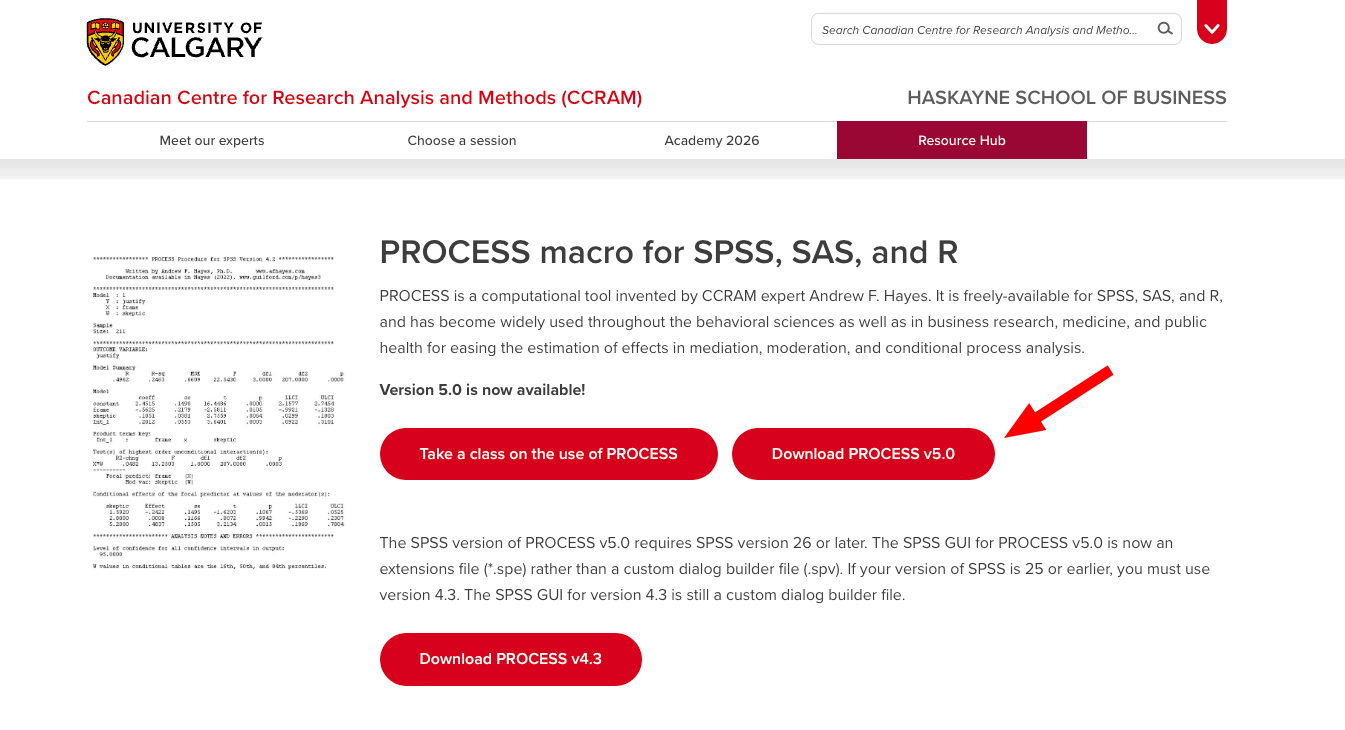
Download PROCESS macro from CCRAM
Step 2: Extract the PROCESS Files
- Once the download is completed, double-click on the .zip file to open the archive
- The .zip file contains directories with files for PROCESS installation on R, SAS, and SPSS, along with documentation
- In this guide, we will focus on the PROCESS for SPSS directory only

Extract PROCESS macro files
- Select and drag-and-drop the PROCESS v5.0 for SPSS directory to a safe location on your disk (e.g., Documents, Desktop, or Program Files)
Important: Choose a location where you won't accidentally delete the PROCESS directory in the future.
Step 3: Install PROCESS Extension in SPSS
- Launch SPSS Statistics on Windows
- On the SPSS top menu, navigate to Extensions → Extension Hub

Access Extension Hub in SPSS
- In the Extension Hub window, click Install Local Extension
- Navigate to the PROCESS for SPSS directory you extracted earlier
- Select the process.spe file (note: this is .spe, not .spd for v5.0)
- Click Open to start the installation
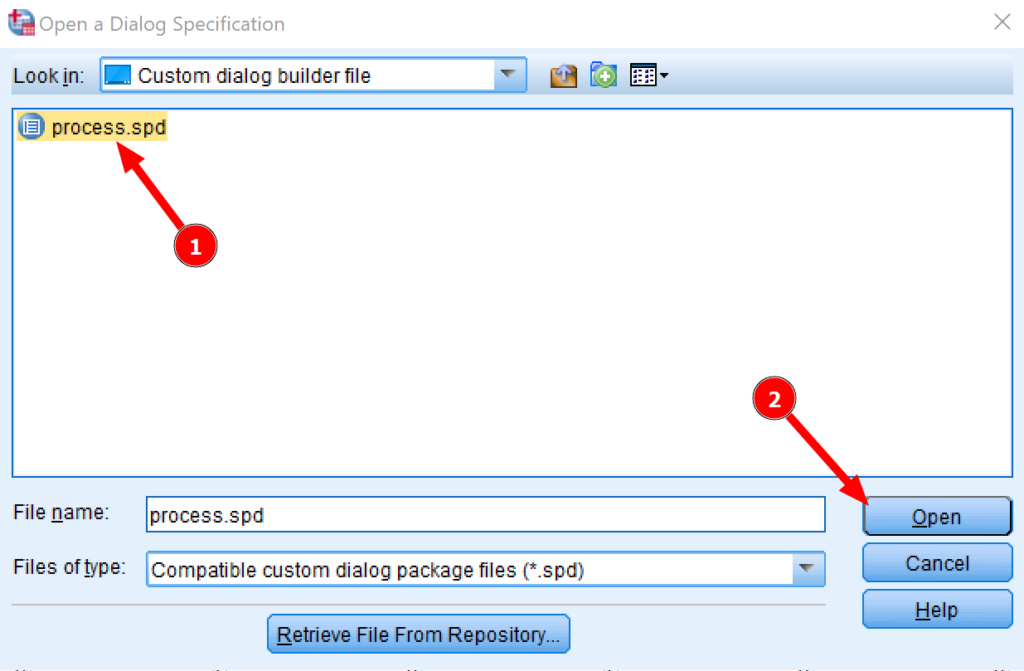
Install PROCESS macro on SPSS Windows using .spe file
- SPSS will install the PROCESS extension. Click OK when the installation completes

PROCESS macro installation confirmation
Step 4: Launch PROCESS in SPSS
- To launch PROCESS, go to Analyze → Regression
- On the Regression menu, you should see a new entry: PROCESS v5.0 by Andrew F. Hayes
- Click on it to open PROCESS
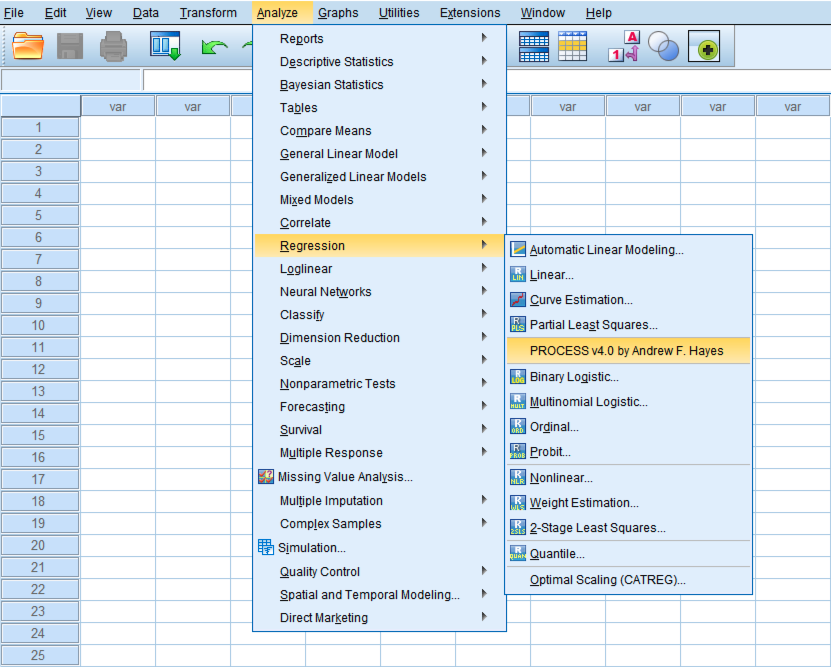
Launch PROCESS macro in SPSS
Note: You need to have a dataset already loaded in SPSS. If no data is loaded, PROCESS will prompt you to open a data file first.
If everything is installed correctly, you should see the PROCESS interface window:
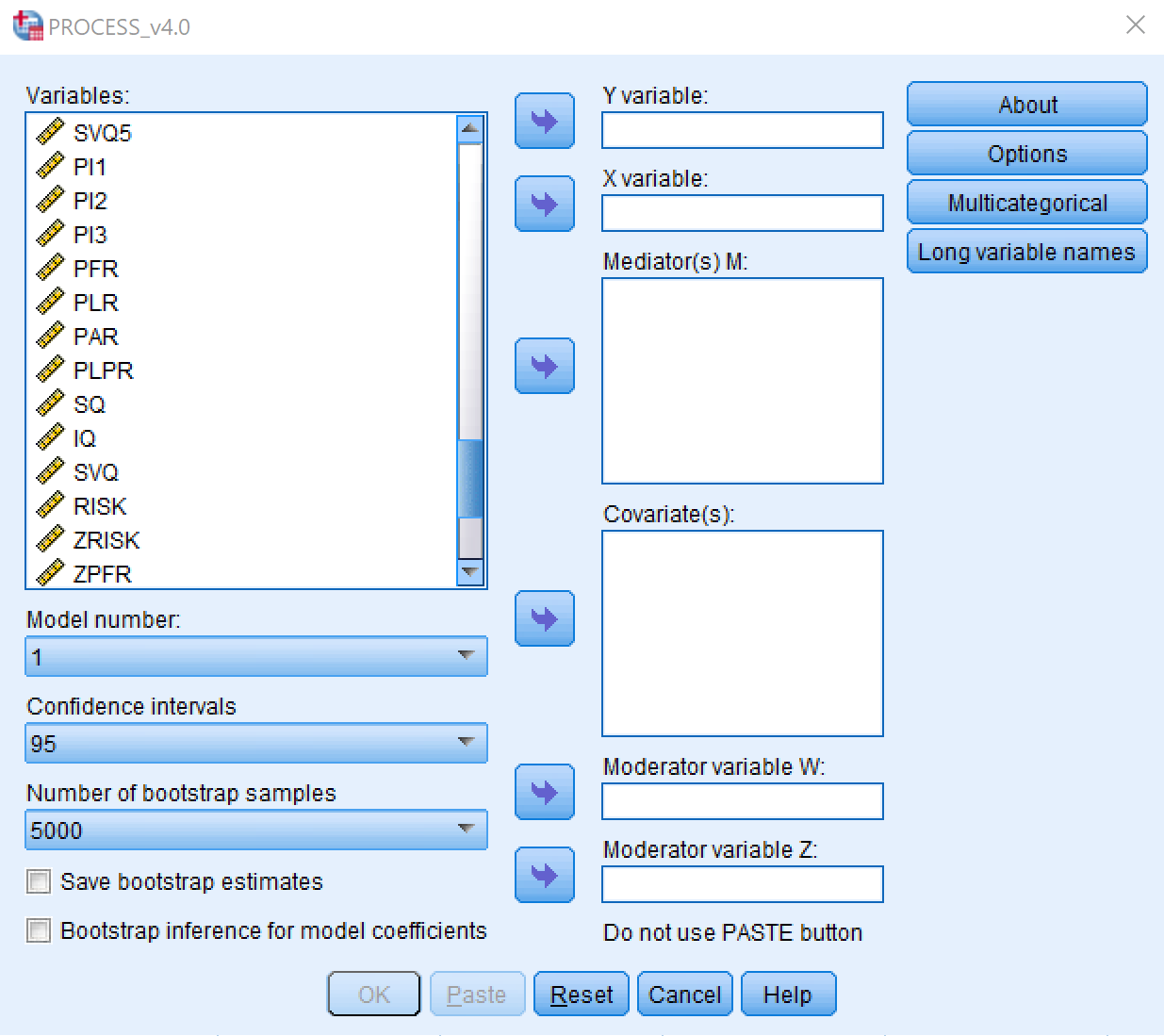
PROCESS v5.0 interface in SPSS
Congratulations! You've successfully installed PROCESS macro v5.0 in SPSS on Windows.
How To Install PROCESS Macro in SPSS [macOS]
Installing PROCESS on a Mac computer is very similar to the Windows installation. You can follow the same basic steps with one additional macOS-specific requirement for file system access.
Step 1: Download PROCESS v5.0
- Open your browser and navigate to the CCRAM Resource Hub at the University of Calgary
- Scroll to the bottom of the page and click the Download PROCESS button in the "PROCESS macro for SPSS, SAS, and R" section
Step 2: Extract PROCESS Files
- Once the download is completed, double-click on the .zip file to extract it
- Copy the PROCESS for SPSS folder to a safe location on your computer (e.g., Documents or Applications)
Step 3: Grant File System Access (macOS Catalina or Higher)
If you're using macOS Catalina or a later version, you need to grant SPSS access to your file system before installing extensions.
- On your Mac, click the Apple logo (top left corner) and select System Preferences
- On the System Preferences window, click on the Security & Privacy icon
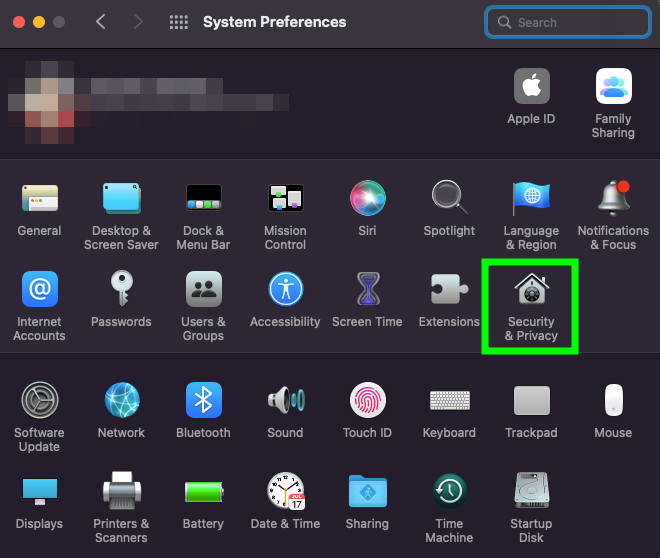
System Preferences on macOS
- Select the Privacy tab, and on the left side scroll down and select Full Disk Access
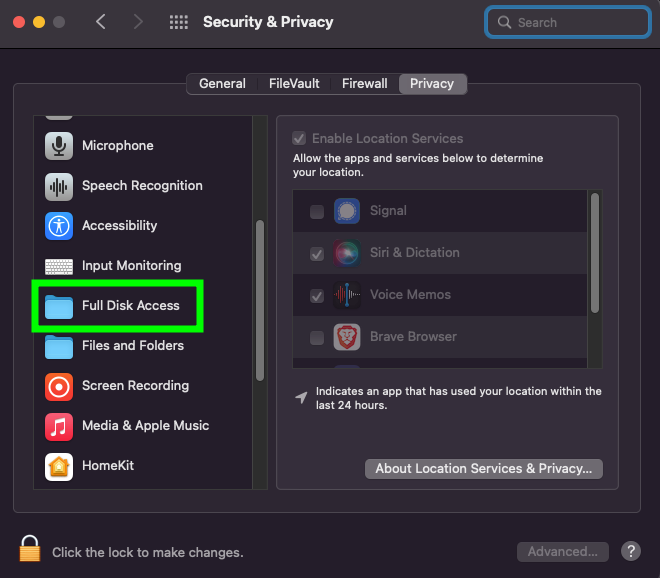
System Preferences Privacy window on macOS
- Click on the lock icon on the bottom left and enter your password to unlock the privacy options
- Click on the + sign to launch a Finder window
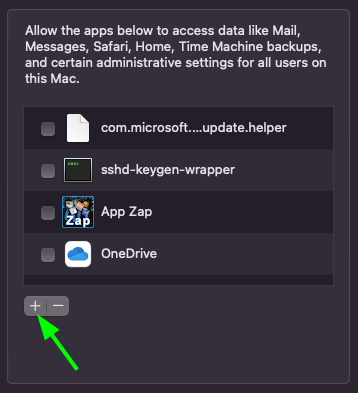
Allowed applications macOS
- Press Command + Shift + G on your keyboard to open the Go to Folder dialogue window
- Type /bin and double-click on the bin folder once displayed
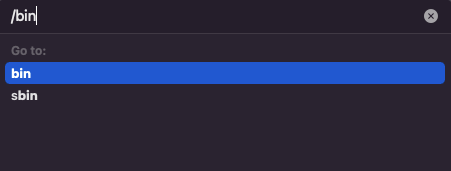
Go to Folder macOS
- Search for a file called sh, select it, then press the Open button. The sh file should now be added to the allowed applications list
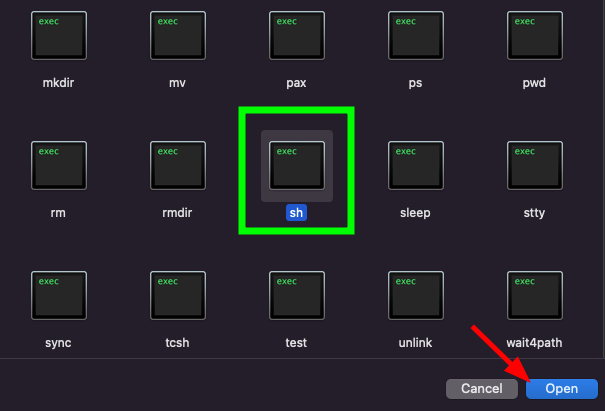
Fix SPSS file access issue on SPSS macOS
- Click on the lock icon to prevent further changes and close the Security & Privacy window
Step 4: Install PROCESS Extension
- Close and reopen SPSS on your computer
- Launch SPSS Statistics on macOS
- Navigate to Extensions → Extension Hub
- In the Extension Hub window, click Install Local Extension
- Navigate to the PROCESS for SPSS folder you extracted earlier
- Select the process.spe file
- Click Open to install
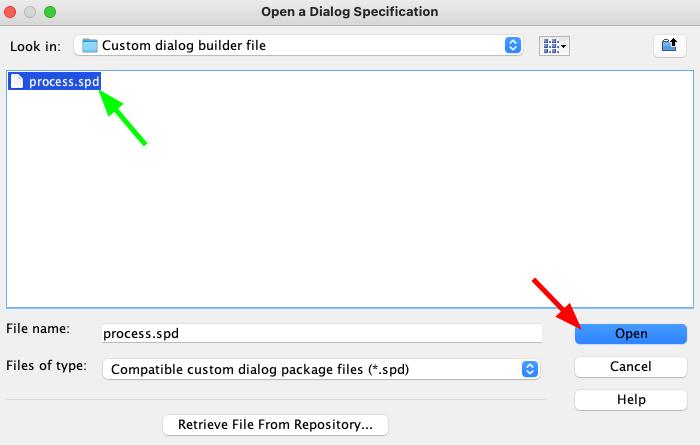
Install PROCESS on SPSS macOS
- PROCESS is now installed on SPSS. Click OK to close the dialogue window

PROCESS SPSS installation dialogue window
Step 5: Launch PROCESS
- Launch PROCESS by navigating to Analyze → Regression in SPSS
- Select PROCESS v5.0 by Andrew F. Hayes
You will need to have a dataset already loaded in SPSS for PROCESS macro to start.
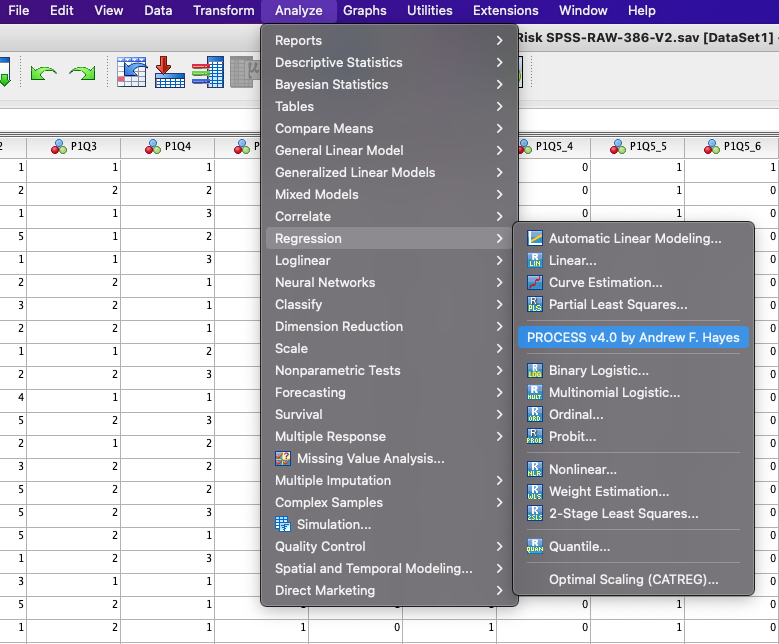
Launch PROCESS macro on SPSS macOS
Quick Tour of the PROCESS Macro Interface
Now that PROCESS is installed successfully on your Windows or macOS computer, let's have a quick look at the PROCESS interface.
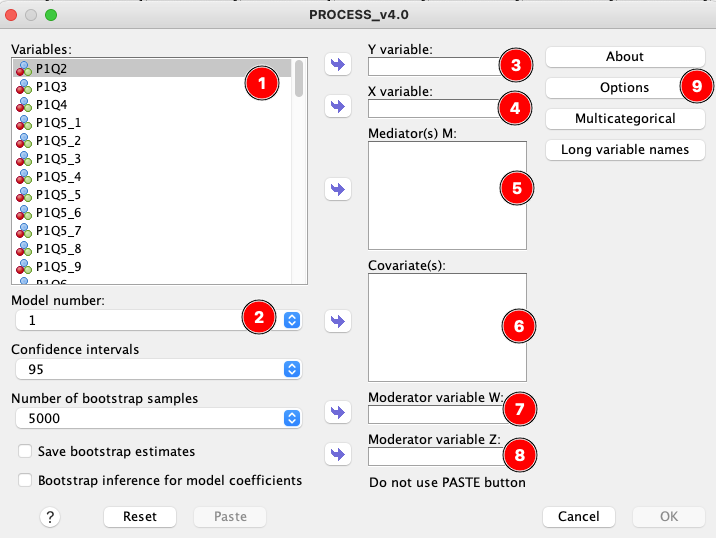
PROCESS macro GUI – a quick overview
- Variables box shows all the variables present in your dataset. This is very similar to any other SPSS window.
- Models – There are a large number of models available depending on your use case. PROCESS version 5.0 has 92+ models available. Model 4 is commonly used for simple mediation analysis. For complex models, refer to Andrew Hayes' Introduction to Mediation, Moderation, and Conditional Process Analysis book.
- Y variable represents the Dependent Variable in your study.
- X variable represents the Independent Variable in your study.
- Mediators (M) – Add one or multiple mediator variables for your model.
- Covariates – Add one or more covariate (continuous/extraneous) variables for your model.
- Moderator W – Add a first moderator variable (W) for your model.
- Moderator Z – Add a second moderator variable (Z) for your study.
- Options – The Options window allows you to customize your analysis with features such as: display covariance matrix, show regression coefficients, interactions, indirect and total effects, residual correlations, and much more.
A great PROCESS macro feature is that you can mean center your variables (construct products) with a simple click without having to calculate them separately in SPSS. If you've ever done a moderator analysis in SPSS, you know how valuable this feature is.
Troubleshooting Common PROCESS Installation Issues
Issue 1: "Extension Hub" Option Not Available
Problem: You can't find "Extension Hub" in the Extensions menu.
Solution:
- You're likely using SPSS version 25 or older. Extension Hub is only available in SPSS 26+.
- Fix: Either upgrade to SPSS 26 or higher, OR download PROCESS v4.x and install using the older "Custom Dialog" method:
- Go to Extensions → Utilities → Install Custom Dialog (Compatibility mode)
- Select the process.spd file instead of .spe
Issue 2: Can't See .spe File in Installation Directory
Problem: When browsing for the PROCESS file, you don't see any .spe files.
Solution:
- Windows: Make sure "All Files (.)" is selected in the file type dropdown
- macOS: You may need to grant Full Disk Access to SPSS (see macOS Step 3 above)
- Alternative: The file might actually be named process.spd if you downloaded PROCESS v4.x instead of v5.0
Issue 3: PROCESS Doesn't Appear in Analyze → Regression Menu
Problem: After installation, PROCESS doesn't show up in the Regression menu.
Solution:
- Completely close SPSS and reopen it
- Make sure you have a dataset loaded (PROCESS won't appear without data)
- Verify the installation completed successfully without errors
- Try reinstalling the extension
Issue 4: "Permission Denied" Error on macOS
Problem: Installation fails with a permission error on macOS.
Solution:
- Follow the "Grant File System Access" steps (macOS Step 3)
- Make sure you've added the sh file to Full Disk Access
- Restart SPSS after changing permissions
- Run SPSS with administrator privileges if needed
Issue 5: PROCESS Opens But Variables Don't Load
Problem: PROCESS window opens but your dataset variables don't appear.
Solution:
- Make sure your dataset is the active window in SPSS
- Check that your variables have appropriate measurement levels (scale, nominal, ordinal)
- Close and reopen PROCESS
- Try loading a different dataset to test if the issue is data-specific
Frequently Asked Questions
Wrapping Up
You've successfully learned how to download and install PROCESS macro in SPSS on both Windows and macOS operating systems. PROCESS is an incredibly powerful tool that simplifies mediation, moderation, and conditional process analysis.
Key Takeaways:
- PROCESS v5.0 requires SPSS 26+ and uses .spe files with Extension Hub installation
- Older SPSS versions (below 26) need PROCESS v4.x with .spd files
- macOS users need to grant Full Disk Access to SPSS
- PROCESS is completely free for academic and commercial use
Next Steps:
- Explore the PROCESS interface with your own data
- Learn practical applications: Mediation Analysis in SPSS
- Master moderation techniques: Moderation Analysis in SPSS
- Understand the difference: Mediators vs. Moderators in Research
Feel free to explore the PROCESS macro statistical tool, and don't forget to give credit to Andrew F. Hayes for providing such an amazing analysis tool for free!